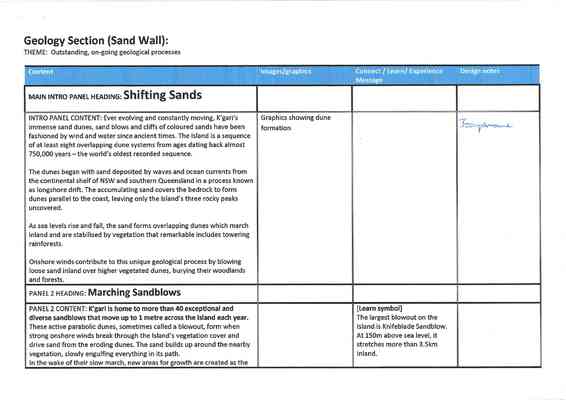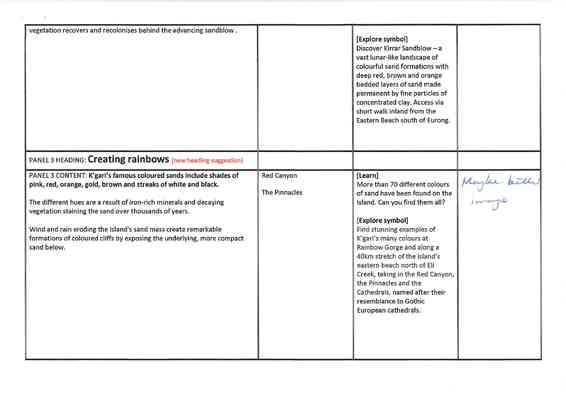Pages
USC697_0001
[USC697] Fraser Island Interpretive Centre
The Centre will address a gap in knowledge and understanding of the global values of the world's largest sand island and encourage exploration and awareness. It is designed to complement other current and planned interpretation on the island and wider region.
OUTSIDE ENTRANCE THEME:
| Content | Images/graphics | Connect/Learn/Experience Message | Design notes |
|---|---|---|---|
| Welcome message to encourage visitation. | USC and KFBLogos | ||
| To include brief overview of joint USC and KFB project |
| Content | Images/graphics | Connect/Learn/Experience Message | Design notes |
|---|---|---|---|
| MAIN INTRO PANEL HEADING: | |||
| Like nowhere else on earth | here slots | ||
| Outside | |||
| .. | .. | .. | .. |
| Some places are truly magical. The original custodians of this island knew | --- | --- | --- |
|---|
The island offer an almost spiritual experience. Its beauty is mind blowing. And its unique ecology and geology like to defy nature's conventions.
USC697_0002
PANEL 2 CONTENT: Paradise for more than 60,000 years, the Butchulla People followed three lores to live in harmony with K'gari's animals and plants, with its abundant fresh water lakes providing a source of life for all. Life changed forever with the arrival of Europeans in the 1850's. For about 130 years K'gari was logged for timber and for 25 years it's sand was mined for minerals. In the 1970's, conservationists led campaigns to secure protection and global recognition for the island; first ending sand-mining and eventually stopping logging in 1991. •Bring back to three lores-experiencing paradise
(Handwritten) Panel on their own Three Lores What is good for the land must come first Do not take or touch anything that does not belong to you If you have plenty, you must share.
(Handwritten) Inside front entrance
PANEL 3 HEADING: Making the list PANEL 3 CONTENT In 1992, K'gari gained a place on one of the world's most sought-after lists- UNESCO's World Heritage Register. Joining locations such as the Great Barrier Reef, Kakadu, Galapagos Islands and the Amazon, it was officially recognised as one of earth's most outstanding natural wonders. To gain World Heritage status, an area must meet at least one of ten selection criteria. Fraser Island fulfilled three: 1. Exceptional natural beauty 2. Outstanding example of the earth's history, including on-going geological processes 3. Outstanding evolutionary processes of ecology and biology
Three hero shots to illustrate: Beauty-beach scene Geology-sand blow ecology-Wanggoolba Creek
[Learn symbol] What does it mean? World Heritage-lisitng by the United Nations Educational, Scientific and Cultural Organisation (UNESCO) recognises K'gari's exceptional universal value and ensures its protection and conservation.
(Handwritten) Inside front entrance Central Station Creek Lake McKenzie Kirra Sandblow
USC697_0003
Geology Section (Sand Wall): THEME: Outstanding, on-going geological processes Content Images/graphics Connect/learn/Experience Design notes Message MAIN INTRO PANEL HEADING: Shifting Sands
INTRO PANEL CONTENT: Ever evolving and constantly moving, K'gari's immense sand dunes, sand blows and cliffs of coloured sands have been fashioned by wind and water since ancient times. The Island is a sequence of at least eight overlapping dune systems from ages dating back almost 750,000 years-the worlds's oldest recorded sequence.
The dunes began with sand deposited by waves and ocean currents from the continental shelf of NSW and southern Queensland in a process known as longshore drift. The accumulating sand covers the bedrock to form dunes parallel to the coast, leaving only the island's three rocky peaks uncovered.
As sea levels rise and fall, the sand forms overlapping dunes which march inland and are stabilised by vegetation that remarkable included towering rainforests.
Onshore winds contribute to this unique geological process by blowing loose sand inland over higher vegetated dunes, burying their woodlands and forests.
Graphics showing dune Improve (crossed out) formation
PANEL 2 HEADING: Marching Sandblows
PANEL 2 CONTENT: K'gari is home to more than 40 exceptional and diverse sandblows that move up to 1 metre across the island each year. These active parabolic dunes, sometimes called a blowout, form when strong onshore winds break through the Island's vegetation cover and drive sand from the eroding dunes. The sand build's up around the nearby vegetaion, slowly engulfing everything in its path. In the wake of their slow march, new areas for growth are created as the
[Learn symbol] The largest blowout on the Island is Knifeblade Sandblow. At 150m above sea level, it stretches more than 3.5km inland.
USC697_0004
| . | . | . | . |
|---|---|---|---|
| vegetation recovers and recolonises behind the advancing sandblow. | [Explore symbol] Discover Kirrar Sandblow - a vast lunar-like landscape of colourful sand formations with deep red, brown and orange bedded layers of sand made permanent by fine particles of concentrated clay. Access via short walk inland from the Eastern Beach south of Eurong. | ||
| PANEL 3 HEADING: Creating rainbows (new heading suggestion) | |||
| PANEL 3 CONTENT: K'gari's famous coloured sands include shades of pink, red, orange, gold, brown and streaks of white and black. The different hues are a result of iron-rich minerals and decaying vegetation staining the sand over thousands of years. Wind and rain eroding the Island's sand mass create remarkable formations of coloured cliffs by exposing the underlying, more compact sand below. | Red Canyon ; The Pinnacles | [Learn] ; More than 70 different colours of sand have been found on the Island. Can you find them all? [Explore symbol] Find stunning examples of K'gari's many colours at Rainbow Gorge and along a 40km stretch of the Island's eastern beach north of Eli Creek, taking in the Red Canyon, the Pinnacles and the Cathedrals, named after their resemblance to Gothic European cathedrals. | Maybe better image |
USC697_0005
| . | . | . | . |
|---|
|MAIN INTRO CONTENT: K'gari's sand mass is based for an incredible landscape of ancient freshwater lakes, including the highest and largest dune lakes in the world.
Some are believed to have formed up to 300 000 years ago - the oldest lake sediment discovered in coastal Australia and probably the world's oldest coastal record of climatic change during the Ice Age.
Unique in shape and colour, the island's 100 lakes appear in a rich mix of settings - from rainforests to colourful heaths.
Each is formed by a complex relationship between the dunes around it, the water flowing from below and above, and K'gari's trees and plants.
| With the sand acting like a filter, the water is clear and pure. It can also be coloured by plant tannins, giving some lakes distinctive red and black tones. |
|---|
| Graphic showing different types of lake formations |
|---|




